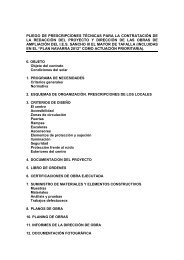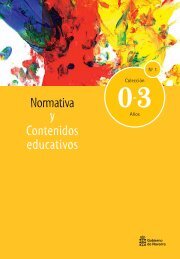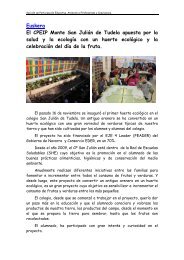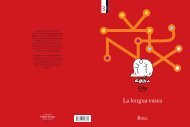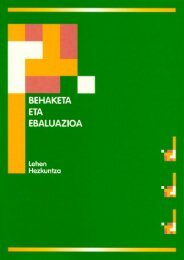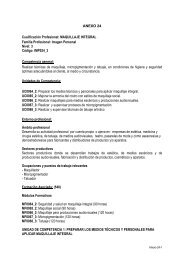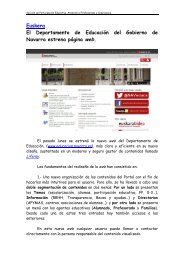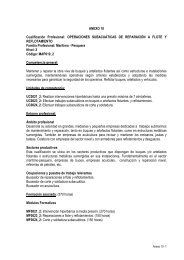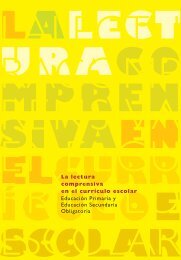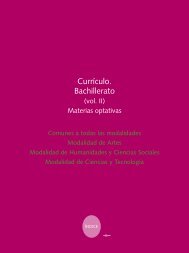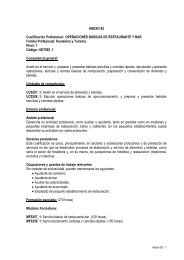A Tribute to New York - Navarra
A Tribute to New York - Navarra
A Tribute to New York - Navarra
Create successful ePaper yourself
Turn your PDF publications into a flip-book with our unique Google optimized e-Paper software.
Pilar San<strong>to</strong>s Tambo A <strong>Tribute</strong> <strong>to</strong> <strong>New</strong> <strong>York</strong><br />
=<br />
= 77. 0/204 >03<br />
(Between brackets the numbers of the sections of the unit in which each is dealt with).<br />
I have subdivided this section in<strong>to</strong> reading skills and writing skills, and in the next<br />
section –reflection on language– I have included the test preparation techniques. It is<br />
very difficult <strong>to</strong> draw the line among all of them and <strong>to</strong> avoid a certain degree of<br />
overlapping because, on the one hand, what I have called test preparation techniques are<br />
in fact reading or writing skills or subskills sometimes. And on the other hand, some of<br />
the receptive skills are in fact an introduction and preparation for active production.<br />
As I explained in the Introduction <strong>to</strong> the unit section a great deal of oral practise is also<br />
provided, mainly when introducing each section, in order <strong>to</strong> trigger the students’<br />
previous knowledge of the different <strong>to</strong>pics, which will allow them <strong>to</strong> interact with the<br />
texts in a more successful way. And there is also an introduction <strong>to</strong> debate techniques in<br />
the section about the United Nations. However, I do not want <strong>to</strong> get in<strong>to</strong> further details<br />
with the oral skills because I prefer <strong>to</strong> keep the focus on the main issues I introduced<br />
above: teaching reading and writing strategies through the culture of the Englishspeaking<br />
countries.<br />
Reading skills and subskills Writing skills and subskills<br />
• Brains<strong>to</strong>rming (<strong>to</strong> trigger interaction<br />
with text) (2, 3, 4, 5, 6, 7, 8, 9, 10)<br />
• Using the dictionary (2)<br />
• Guessing the meaning of unknown<br />
words from context, related words or<br />
cognates (2, 6, 10)<br />
• Understanding brochures (3)<br />
• Understanding maps (3)<br />
• Analysing data (7)<br />
• Scanning (3)<br />
• Understanding the use of paragraphs<br />
(3, 4, 5)<br />
• Skimming (4)<br />
• Understanding the difference between<br />
fact and opinion (4)<br />
• Understanding the writer’s intention<br />
(4)<br />
• Understanding textual coherence (5)<br />
• Understanding the use of connec<strong>to</strong>rs<br />
(7, 8)<br />
• Understanding the use of reference<br />
28<br />
• Writing formal letters (1)<br />
• Writing informal letters (2, 9)<br />
• Summarising (2, 3, 9)<br />
• Sharing a common code for text<br />
correction (2)<br />
• Keeping a record of one’s most<br />
common mistakes (2)<br />
• Using paragraphs (3, 4)<br />
• Brains<strong>to</strong>rming techniques (3, 5, 6, 7)<br />
• Sorting out ideas (3)<br />
• Using paragraphs (4)<br />
• Using the right punctuation (4)<br />
• Writing an opinion (4)<br />
• Exchanging ideas with classroom<br />
mates (4)<br />
• Textual coherence (5)<br />
• Writing an introduction and a<br />
conclusion (5, 7)<br />
• Writing a description (6, 9, 10)<br />
• Using connec<strong>to</strong>rs (4, 5, 7, 8, 9)



